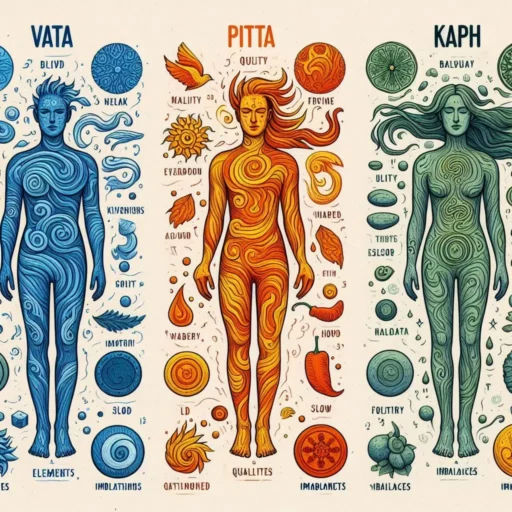Ayurveda, an ancient system of holistic wellness originating in India, is a comprehensive approach to health that harmonizes the mind, body, and spirit.
It seeks to establish balance and well-being through personalized practices tailored to an individual’s unique constitution.
What is Ayurveda?
Ayurveda, often hailed as the “Science of Life,” is a profound and ancient system of holistic wellness that traces its origins to the Indian subcontinent.
Rooted in the wisdom of Vedic traditions, Ayurveda is not merely a medical system but a way of life that encapsulates the interconnectedness of the individual with their environment.
At its essence, Ayurveda views health as a dynamic equilibrium between the mind, body, and spirit. It goes beyond mere symptom alleviation, aiming to prevent illness by addressing the root causes of imbalances.
In Ayurvedic philosophy, the human body is seen as a microcosm of the larger universe, intricately linked to the elements and cycles of nature.
The key to well-being lies in understanding and harmonizing with these natural rhythms.
Central to Ayurveda are the doshas—Vata, Pitta, and Kapha—which represent the fundamental energies governing various physiological and psychological functions.
The unique combination of these doshas in an individual determines their constitution or Prakriti.
Ayurveda’s approach is deeply individualized, recognizing that each person is distinct with specific needs. It emphasizes preventive measures through a balanced lifestyle, proper nutrition, and mind-body practices.
Daily routines, dietary choices, and herbal remedies are tailored to an individual’s doshic makeup, ensuring a holistic and personalized approach to health. Ayurveda also integrates practices like yoga and meditation, recognizing their profound impact on overall well-being.
As Ayurveda gains global recognition, its timeless principles continue to resonate, offering a holistic roadmap to a healthier, more balanced life.
The integration of ancient wisdom with modern living makes Ayurveda a relevant and transformative guide for those seeking optimal health and wellness.
Historical Roots of Ayurveda
Dating back to ancient scriptures, Ayurveda has evolved over centuries, drawing wisdom from Vedic texts and sages. Its historical roots contribute to the richness and time-tested efficacy of this holistic system.

The historical roots of Ayurveda delve deep into the fabric of ancient Indian civilization, where the seeds of this profound wellness system were sown.
The origins of Ayurveda can be traced to the sacred Vedas, particularly the Rigveda, which contains hymns praising the medicinal properties of various plants.
As the Vedic era unfolded, the knowledge and practices related to health and healing were systematically compiled into the Atharvaveda, one of the four Vedas, dedicated to the knowledge of charms and spells.
Ayurveda’s foundational text, the “Charaka Samhita,” attributed to the sage Charaka, and the “Sushruta Samhita,” credited to Sushruta, an ancient surgeon, emerged around the 6th century BCE.
These texts not only laid down the principles of Ayurveda but also detailed surgical procedures, pharmacology, and systematic classifications of diseases.
The systematic organization of Ayurvedic knowledge in these scriptures marked a significant milestone in the evolution of this ancient system.
Throughout history, Ayurveda continued to flourish and adapt, absorbing influences from various cultures and regions. The Mauryan and Gupta periods (322 BCE – 550 CE) witnessed the establishment of Ayurvedic schools and the development of advanced medical theories.
During this time, Ayurveda became an integral part of educational curricula, with scholars contributing to its refinement and expansion.
The influence of Ayurveda spread beyond the Indian subcontinent, reaching regions like Tibet, China, Persia, and the Arab world. Its principles were translated into various languages, and Ayurvedic texts became revered sources of knowledge in diverse cultures.

Despite periods of political upheaval and foreign invasions, Ayurveda endured, and its wisdom was carefully preserved by dedicated practitioners and scholars.
In the 20th century, renewed interest in traditional healing systems brought Ayurveda to the forefront of global wellness discussions.
Today, Ayurveda stands as a testament to the resilience and enduring value of ancient knowledge, offering a holistic approach to health that transcends time and cultural boundaries.
The historical roots of Ayurveda not only ground it in tradition but also provide a solid foundation for its continued relevance in the modern world.
Key Principles of Ayurveda
The Concept of Doshas
Doshas are fundamental energies that govern various physiological and psychological functions in the body. Understanding Vata, Pitta, and Kapha forms the cornerstone of Ayurvedic principles.
Understanding Vata, Pitta, and Kapha
At the heart of Ayurveda lies the profound concept of doshas, which are the elemental forces believed to shape an individual’s constitution and determine their unique physical and mental attributes.
The doshas—Vata, Pitta, and Kapha—are derived from the five elements (earth, water, fire, air, and ether) and manifest in different combinations within each person.

Vata:
Governed by the elements of air and ether, Vata is associated with movement, creativity, and flexibility. Imbalances can lead to anxiety, restlessness, and digestive issues.
Pitta:
Linked to the elements of fire and water, Pitta is associated with metabolic processes, digestion, and transformation. An excess of Pitta may result in irritability, inflammation, and digestive disorders.
Kapha:
Rooted in the elements of earth and water, Kapha governs stability, structure, and lubrication. Imbalances may manifest as lethargy, weight gain, and respiratory issues.
Understanding one’s doshic constitution, or Prakriti, is essential in Ayurveda. This unique combination of doshas at birth influences physical appearance, mental tendencies, and overall health.
While everyone has a dominant dosha, each individual possesses a blend of all three, with their proportions determining individuality.
Balancing Your Doshas
Ayurveda places great emphasis on maintaining doshic equilibrium for optimal health. Lifestyle adjustments, dietary choices, and mindfulness practices are tailored to balance individual doshas.
For instance, a Vata-predominant individual may benefit from grounding activities, warm foods, and a regular routine, while a Pitta-dominant person may focus on cooling practices and a diet that pacifies excess heat.

The intricate dance of doshas within the body is a central theme in Ayurveda, guiding individuals on a personalized journey towards wellness.
By understanding and harmonizing these fundamental energies, one can achieve balance and unlock the path to vibrant health.
Ayurvedic Lifestyle Practices
Ayurvedic lifestyle practices form a holistic blueprint for harmonizing daily routines, dietary habits, and seasonal adjustments.
These practices recognize the interconnectedness of an individual with the natural world and aim to align personal well-being with the broader rhythms of existence.
Daily Routines (Dinacharya):
Ayurveda places great importance on daily routines, known as dinacharya, as they set the tone for overall health and balance.
Waking up during the Brahma Muhurta (around 4–6 am), a time considered spiritually auspicious, is encouraged.
This early rise aligns with Vata’s influence and promotes a calm and focused start to the day.
Following this, practices such as tongue scraping, oil pulling, and self-massage with warm oil are recommended to enhance oral and skin health, promoting a sense of grounding.
Mindful eating is another key aspect of dinacharya, encouraging individuals to savor and appreciate their meals.
Eating in a calm environment, without distractions, aids digestion and allows the body to absorb nutrients efficiently.
Establishing a regular sleep schedule is equally vital, as it supports the body’s natural circadian rhythms, contributing to overall balance.
Seasonal Adjustments (Ritucharya):
Ayurveda acknowledges the impact of seasonal changes on the body and mind, emphasizing the need for adjustments to maintain equilibrium.
Ritucharya, or seasonal routine, guides individuals on adapting their diet, activities, and self-care practices according to the prevailing season.
For example, during the hot summer months when Pitta tends to be aggravated, cooling foods like cucumbers and melons are recommended.
Conversely, in cold winter months, warming spices and nourishing, hearty foods support the body’s need for insulation.
Ritucharya encourages individuals to attune themselves to nature’s cycles, fostering resilience and preventing imbalances associated with seasonal changes.
Dietary Guidelines:
Ayurvedic dietary principles go beyond nutritional content, focusing on the inherent qualities of foods and their impact on doshic balance.
The belief that ‘you are what you eat’ underscores the significance of food in Ayurveda. Individuals are categorized into different doshic constitutions, and dietary recommendations are tailored accordingly.

For instance, a Vata-predominant individual may benefit from warm, nourishing foods that offer stability, while a Pitta-dominant person may find relief in cooling, hydrating options.
Kapha-predominant individuals may benefit from a diet rich in warming spices and lighter foods to balance their inherent stability.
In essence, Ayurvedic lifestyle practices are a conscious and personalized approach to living in harmony with oneself and the world.
By integrating these practices into daily life, individuals can cultivate resilience, balance, and a deep connection to the rhythms of nature.
Herbs and Remedies in Ayurveda
Nurturing Well-being through Nature’s Pharmacy
Ayurveda, deeply rooted in nature, relies on a rich tapestry of herbs and remedies to restore and maintain well-being.
This ancient system recognizes the inherent healing potential within the natural world, encapsulating the essence of holistic health through botanical interventions.
Popular Ayurvedic Herbs:
Central to Ayurvedic principles is the use of herbs, each possessing unique qualities and therapeutic benefits.
Among the standout herbs is turmeric, celebrated for its potent anti-inflammatory and antioxidant properties. It is widely used to support joint health, boost immunity, and enhance overall vitality.

Ashwagandha, another revered herb, is renowned for its adaptogenic qualities, aiding the body in adapting to stress and promoting a sense of balance.
It is a cornerstone in Ayurvedic formulations aimed at bolstering resilience and vitality.
Brahmi, known for its cognitive-enhancing properties, is often used to support mental clarity and memory. This herb is integral to Ayurvedic formulations targeting neurological well-being.
Ayurveda doesn’t merely focus on individual herbs but often utilizes synergistic blends known as formulations or “Rasayanas” to enhance their effectiveness.
These formulations are crafted with precision, taking into account the doshic constitution and the specific needs of the individual.
Home Remedies for Common Ailments:
Ayurveda empowers individuals to take charge of their health with accessible home remedies. Herbal teas, for example, are a popular and simple intervention for various conditions. Ginger tea, with its warming properties, aids digestion and alleviates nausea.
Tulsi (Holy Basil) tea, revered for its immune-boosting qualities, is a staple in Ayurvedic households.
Oil massages, or “Abhyanga,” are another home remedy deeply ingrained in Ayurveda.
Using warm sesame or coconut oil, this practice not only nourishes the skin but also calms the nervous system and promotes a sense of grounding.
Different oils are recommended based on doshic imbalances, showcasing the personalized nature of Ayurvedic remedies.
Ayurvedic herbs and remedies extend beyond symptom management, aiming to address the root causes of imbalances.
Whether used preventively or as targeted interventions, these natural interventions embody the essence of Ayurveda’s holistic approach, where healing is viewed as a harmonious collaboration between humans and the natural world.
Yoga and Ayurveda: Unifying Mind and Body
Yoga and Ayurveda, two ancient sister sciences originating from the Vedic tradition, converge in their shared goal of fostering holistic well-being.
This synergy recognizes the intricate connection between the body and mind, offering a comprehensive approach to health and self-realization.
The Synergy Between Yoga and Ayurveda:
At the heart of the relationship between Yoga and Ayurveda lies the recognition that optimal health cannot be achieved by focusing solely on the physical body or the mind in isolation.
While Ayurveda provides a roadmap for individualized well-being, yoga serves as a powerful tool to harmonize the body, mind, and spirit.

Yoga encompasses a vast array of practices, including physical postures (asanas), breath control (pranayama), meditation, and ethical guidelines for righteous living (yamas and niyamas).
The integration of these practices aligns seamlessly with Ayurvedic principles, creating a unified approach to health.
For instance, yoga postures can be tailored to pacify specific doshic imbalances, fostering balance and promoting overall vitality.
Tailoring Yoga Practices to Doshas:
Ayurveda recognizes that individuals have unique doshic constitutions, and imbalances can manifest differently in each person.
Similarly, yoga practices can be customized to address these doshic imbalances. For someone with excess Vata, calming and grounding yoga poses and meditation techniques may be recommended.
Individuals with elevated Pitta may benefit from cooling and soothing postures, while those with Kapha dominance may find invigorating and energizing practices more beneficial.
The incorporation of pranayama, or breath control, further deepens the integration of Yoga and Ayurveda.
Specific breathing techniques can be chosen based on doshic imbalances to restore balance in the subtle energies of the body.
The shared philosophy of both systems emphasizes the importance of self-awareness, mindfulness, and conscious living.
By integrating Ayurvedic principles into yoga practices, individuals can tailor their routines to suit their unique constitution, promoting not only physical flexibility and strength but also mental clarity and emotional balance.
The interplay between Yoga and Ayurveda extends beyond the mat, influencing lifestyle choices, dietary habits, and overall well-being.
This harmonious synergy offers a holistic approach to health, where the ancient wisdom of these sister sciences converges to guide individuals on a transformative journey toward balance and self-discovery.
Ayurveda in the Modern World
Ayurveda’s Global Resurgence:
The timeless wisdom of Ayurveda, rooted in ancient traditions, is finding renewed relevance in the modern world.
As individuals seek holistic approaches to health that address the complexities of contemporary lifestyles, Ayurveda’s comprehensive system provides a guiding light.
The global resurgence of Ayurveda can be attributed to various factors. First and foremost is a growing disillusionment with the limitations of conventional medicine in addressing chronic and lifestyle-related conditions.
Ayurveda’s emphasis on prevention, individualized care, and a holistic understanding of well-being aligns with the shifting paradigm towards proactive and personalized healthcare.
Furthermore, increased connectivity and access to information have fueled a curiosity about diverse wellness practices.
Ayurveda’s rise is not limited to its cultural origins; it has transcended geographical boundaries, attracting followers from all walks of life seeking a more balanced and mindful existence.
Integrating Ayurvedic Practices Today:
In the hustle and bustle of the modern world, individuals are increasingly drawn to Ayurvedic practices that offer a holistic approach to managing stress, promoting mental well-being, and preventing lifestyle-related ailments.
Ayurveda’s adaptability is evident in its seamless integration into contemporary lifestyles.
Ayurvedic dietary principles, emphasizing fresh, whole foods and mindful eating, align with the growing interest in conscious nutrition.
Yoga, an integral component of Ayurveda, has become a mainstream wellness practice, with millions embracing it for its physical, mental, and spiritual benefits.
Ayurvedic skincare and beauty routines, utilizing natural ingredients and mindful self-care practices, resonate with those seeking alternatives to synthetic and chemically-laden products.
Ayurveda’s emphasis on balance and harmony provides a counterpoint to the often hectic and imbalanced nature of modern living.
As wellness becomes a global pursuit, Ayurveda stands at the intersection of ancient wisdom and modern needs.
The integration of Ayurvedic principles into mainstream health and wellness conversations signifies not just a trend but a fundamental shift towards a more holistic and personalized approach to well-being.
In a world characterized by rapid change, Ayurveda offers a timeless anchor, guiding individuals on a journey towards balance, vitality, and a harmonious coexistence with the demands of the contemporary world.
Challenges and Criticisms
Scientific Scrutiny:
One of the primary challenges facing Ayurveda in the modern world is the demand for scientific validation.
While Ayurveda boasts a rich history and anecdotal evidence supporting its efficacy, the Western scientific paradigm often requires rigorous clinical trials and empirical data.
Critics argue that some Ayurvedic treatments lack the level of scientific scrutiny applied to conventional medicine.
However, it’s essential to recognize that Ayurveda operates on a fundamentally different paradigm, focusing on individualized care and holistic well-being rather than standardized treatments for specific symptoms.
Efforts are underway to bridge the gap between traditional wisdom and contemporary scientific standards, with ongoing research exploring the efficacy and safety of Ayurvedic interventions.
Cultural Misappropriation Concerns:
As Ayurveda gains popularity globally, there is a legitimate concern about cultural misappropriation.
The risk lies in the potential dilution of Ayurveda’s essence, with practices and remedies being extracted from their cultural and historical context.
Critics argue that the commercialization of Ayurvedic products and practices without a deep understanding of their cultural significance may lead to a loss of authenticity.
To address this challenge, there is a growing emphasis on promoting cultural awareness and sensitivity within the Ayurvedic community.
Respectful engagement with the tradition, acknowledgment of its roots, and collaboration with qualified practitioners from the cultural origin of Ayurveda are essential steps toward preserving its authenticity.
Navigating these challenges requires a delicate balance between preserving the integrity of Ayurveda and adapting to the evolving landscape of global wellness.
As Ayurveda continues to integrate into modern healthcare, finding common ground between traditional wisdom and contemporary standards is crucial for its sustained relevance and acceptance.
It is through open dialogue, research, and ethical practices that Ayurveda can address criticisms, overcome challenges, and continue to offer valuable contributions to the well-being of individuals worldwide.
Benefits of Ayurveda
1. Holistic Well-being:
At the core of Ayurveda’s benefits is its commitment to holistic well-being. Unlike conventional medicine that often targets specific symptoms, Ayurveda aims to restore balance to the entire system.
By addressing the root causes of imbalances, Ayurveda provides a roadmap to not just alleviate symptoms but to foster overall health and vitality.
This holistic perspective extends beyond the physical body to encompass mental clarity, emotional balance, and spiritual harmony.
2. Personalized Approach:
One of Ayurveda’s standout features is its personalized approach to health.
Recognizing that each individual is unique, Ayurveda considers factors such as doshic constitution, lifestyle, and environmental influences to tailor interventions.
This level of customization ensures that recommendations resonate with an individual’s specific needs, maximizing the effectiveness of Ayurvedic practices.
3. Preventive Health:
Ayurveda’s emphasis on preventive health sets it apart. Instead of waiting for symptoms to manifest,
Ayurveda guides individuals in making lifestyle choices that align with their constitution, prevent imbalances, and promote long-term health.
This proactive approach empowers individuals to take charge of their well-being and make choices that resonate with their unique doshic makeup.
4. Mind-Body Connection:
Ayurveda recognizes the inseparable connection between the mind and body.
Practices such as meditation and yoga, integral components of Ayurveda, are employed to not only enhance physical health but also to nurture mental clarity, emotional resilience, and spiritual growth.
This mind-body synergy is fundamental to Ayurveda’s approach to comprehensive well-being.
5. Natural Healing:
Ayurveda’s reliance on natural remedies, including herbs, dietary adjustments, and lifestyle practices, aligns with the global trend toward holistic and natural healing.
By harnessing the healing power of nature, Ayurveda minimizes the potential side effects associated with synthetic medications, offering a gentler and sustainable approach to health.
In essence, the benefits of Ayurveda extend far beyond the alleviation of symptoms; they encompass a transformative journey toward wholeness.
As individuals increasingly seek holistic approaches to health, Ayurveda experience and timeless wisdom continues to offer a comprehensive and personalized roadmap to vibrant well-being.
How to Incorporate Ayurveda Into Your Life
1. Understanding Your Dosha:
The first step in incorporating Ayurveda into your life is understanding your doshic constitution.
Various online resources and Ayurvedic practitioners can assist in determining your Prakriti, which represents the unique combination of Vata, Pitta, and Kapha that influences your physical and mental attributes.
2. Mindful Eating:
Ayurveda places great importance on mindful eating. Consider the qualities of food, such as taste, temperature, and texture, and how they influence your dosha.
For example, a Vata-dominant individual may benefit from warm, grounding foods, while a Pitta-dominant person may favor cooling options.
3. Daily Routines:
Establishing daily routines, or dinacharya, is fundamental to Ayurvedic living.
Waking up early, practicing self-care rituals like oil massages or dry brushing, and creating a consistent daily schedule contribute to balance. Tailor these routines based on your dosha for optimal results.
4. Seasonal Adjustments:
Ayurveda recognizes the impact of seasonal changes on the body and mind. Adjust your lifestyle, diet, and activities according to the prevailing season.
For instance, during the hot summer months, favor cooling foods and activities to balance Pitta.
5. Yoga and Meditation:
Integrate yoga and meditation practices into your routine, considering your dosha.
Vata-dominant individuals may benefit from grounding yoga poses, while Pitta-dominant individuals may find solace in calming practices.
Meditation enhances mindfulness and promotes emotional well-being.
6. Ayurvedic Self-Care:
Incorporate Ayurvedic self-care practices into your daily routine.
Oil pulling for oral health, tongue scraping to remove toxins, and herbal skincare routines contribute to holistic well-being.
These practices align with Ayurveda’s emphasis on preventive health.
In essence, incorporating Ayurveda into your life is a journey of self-discovery and conscious living.
By understanding your dosha and aligning your lifestyle choices with Ayurvedic principles, you embark on a personalized path to well-being that embraces the wisdom of this ancient system.
Ayurveda and Modern Medicine: Bridging Traditions
Complementary Approaches:
Ayurveda and modern medicine represent two distinct systems of healthcare, each with its strengths and principles. While modern medicine excels in acute care and technological advancements,
Ayurveda offers a holistic approach that emphasizes preventive health, individualized care, and the interconnectedness of mind, body, and spirit.
The integration of these complementary approaches is gaining recognition as individuals seek a more inclusive and comprehensive approach to well-being.
Integrative Healthcare:
The rise of integrative healthcare reflects a growing acknowledgment of Ayurveda’s potential alongside modern medical interventions.
Individuals are increasingly exploring the benefits of combining Ayurvedic practices, such as dietary adjustments, herbal remedies, and mindfulness, with conventional treatments.
This integrative approach allows for a more personalized and holistic understanding of health, addressing not only symptoms but also underlying imbalances.
Bridging the Gap:
While Ayurveda and modern medicine have coexisted for decades, efforts are intensifying to bridge the gap between these two systems.
Collaborative research projects, shared knowledge platforms, and cross-disciplinary dialogues aim to foster a deeper understanding of the strengths and limitations of each system.
This bridge-building approach seeks to provide individuals with a more informed and nuanced healthcare landscape, allowing them to make choices that resonate with their unique needs and preferences.
As Ayurveda finds its place in the modern medical landscape, it brings with it a rich tapestry of traditional wisdom.
The integration of Ayurvedic principles into contemporary healthcare reflects a broader shift toward a more patient-centric, holistic, and preventive approach.
While challenges persist, the dialogue between Ayurveda experiences and modern medicine signifies a dynamic evolution in the pursuit of optimal health, where the strengths of both systems can coalesce for the benefit of individuals seeking a comprehensive and personalized healthcare experience.
Conclusion
In conclusion, Ayurveda stands as a timeless guide to holistic wellness, offering a harmonious integration of ancient wisdom and modern living. By embracing Ayurvedic principles, individuals can embark on a transformative journey toward optimal health and well-being.
FAQs About Ayurveda
What are the basic concepts of Ayurveda?
Ayurveda, an ancient wellness system, revolves around fundamental concepts such as doshas (Vata, Pitta, Kapha), dhatus (tissues), malas (wastes), agni (digestive fire), and the importance of maintaining balance for optimal health.
What are the 7 stages of Ayurveda?
The seven stages of Ayurveda, known as Sapta Dhatus, encompass Rasa (plasma), Rakta (blood), Mamsa (muscle), Meda (fat), Asthi (bone), Majja (marrow), and Shukra (reproductive tissues).
What are the six basic principles of Ayurveda?
The six fundamental principles in Ayurveda are known as Sankhya, Prakriti, Dosha, Dhatu, Mala, and Agni. These principles form the basis for understanding the body’s constitution, imbalances, and overall well-being.
What are the 5 things in Ayurveda?
Ayurveda emphasizes the Panchamahabhutas, or five elements: Earth, Water, Fire, Air, and Ether. These elements form the basis of doshas, contributing to the unique constitution of individuals.
What are the 4 pillars of Ayurveda?
The four pillars of Ayurveda are considered to be Ahara (diet), Vihara (lifestyle), Aushadhi (medicine), and Sadvidya (spiritual knowledge). These pillars support the holistic approach to well-being in Ayurvedic philosophy.
What is 5 karma in Ayurveda?
The “Pancha Karma” in Ayurveda comprises five therapeutic actions: Vamana (emesis), Virechana (purgation), Basti (enema), Nasya (nasal administration), and Raktamokshana (bloodletting). These practices aim to cleanse and rejuvenate the body, promoting balance and health.
